
November 2014 Newsletter
Click here to view this newsletter in a .pdf with a white background for easy
printing.
I normally try to use some type of alliterative or catchy title for the
monthly newsletter, but I’m fresh out of ideas this time around having
used words like nostalgia, nostrums, and the like in the past. So I
reckon I’ll just call it the November Newsletter and leave it at that.
|
As the last newsletter suggested one of the highlights of my year, every
year, is attending the annual conference of the
Southeastern Outdoor Press Association (SEOPA). The group, some 500 members strong, is often
described as an extended family and each conference is like a family
reunion. This year, as conference chair, I just happened to be the
person in charge. The incoming president of the organization is the
conference chair and takes the president’s position during the event
after having spent the three previous years moving up the officer chain.
While putting together a SEOPA conference requires a great deal of time
and effort, in this instance I was delighted to be in that position. I
was president of the organization 20 years ago so I knew exactly what
faced me, but the deciding factor was where the event was to be held.
SEOPA was founded 50 years ago when 18 writers met at Fontana Village in
the heart of North Carolina’s Great Smokies, and celebrating our 50th
anniversary there was a no brainer.
SEOPA’s Golden Anniversary also provided a golden opportunity to
celebrate and showcase my beloved highland homeland. Two of my seminar
speakers were from the area—my brother, Don, who is a fine photographer
with a passionate love for discovering and preserving the region’s rich
history, and my good friend, Tipper Pressley, who is as committed to
preserving old-time Appalachian days and ways as anyone I know.
Don
spoke on “Bushwhacking Through the Backside of Heaven,” a sort of
combination photo safari/history excursion, while Tipper’s session,
“Blogging from the Heart,” shared her thoughts an experiences on a
wonderful Appalachian blog, “The Blind Pig and the Acorn”.
She also provided the spouses in attendance a special presentation on
how to make dandy biscuits (I except to benefit, in an ongoing fashion,
in a waist-expanding way), chocolate gravy, and kraut. She also fed them
cabbage patch soup, which I can tell you, having already sampled and
savored it, makes mighty fine tucker on a chilly day. On top of their
two excellent presentations, Ron Rash, arguably THE major
Appalachian literary figure of today, was keynote speaker for the event.
Another part of the picture revolved around our hosts—Graham County,
Swain County, and
Fontana Village. They handled us in grand fashion and
let me assure you that you won’t find finer mountain folks anywhere than
those at Fontana Village. If you’ve never been there and have interest
in things such as hiking, lake fishing or stream fishing for trout,
spring wildflowers, fall leaf color, motor biking (think Tail of the
Dragon), horseback riding, disc golf, or a whole bunch more, check them out.
I love the whole region and both Graham and Swain counties have a
great deal to offer, including vast expanses of national park and
national forest, while Fontana Village is a self-contained community you
can’t help but love. In short, my mountain folks did this son of the
Smokies mighty proud.
There were also some moving, special moments on a personal note. A dear
lady from Alabama who is a longtime friend in the outdoor industry, Pam
Swanner, had brought a lovely, handmade walnut cutting board for SEOPA’s
fundraising auction. When she found out I coveted it, she bought it
back, procured scores of signatures from the colleagues who form my
professional family, and then gave it back to me at a meal her
organization, Alabama Black Belt Adventures, hosted.
Typical of mountain folks, I’m a pretty hard-headed and possibly a
somewhat hard-hearted soul. Still, I was so deeply moved that I had to
collect my thoughts and catch my breath before offering some remarks
which were likely more remarkable for their incoherence than anything
else. Now the cutting board adorns our kitchen counter and every time I
cut a piece of meat or slice some fruit I’m reminded of fine friends and
Pam’s wonderful gesture.
Another key aspect of SEOPA conferences is excellence in craft
competition with one’s peers. Awards from the organization are coveted
and difficult to obtain thanks to keen competition. While I’ve been
blessed a number of times over the years in garnering recognition from
the organization for my efforts as a writer, this year I was
particularly fortunate to be recognized in four different categories. I
won third place recognition in the book and conference site story
categories, while my submissions in the outdoor entrepreneur and
magazine short feature categories were recognized with first place
awards.

Receiving SEOPA Excellence in Craft Award,
First Place, Magazine Short.
Since the subject matter of the magazine piece deals with something I
suspect is of more than passing interest to many if not most of you
readers, I’ve decided to include it in this newsletter. The piece on
pocketknives which appears below (I have slightly altered the ending)
drew a warm comment from a judge: “I liked everything about this story.
Nostalgic without being preachy about ‘the good old days.’”
I hope you
will enjoy it, and stay tuned for another update on personal activities
in the next newsletter. I had a good October, because our little state
writers group, the South Carolina Outdoor Press Association, honored me
in multiple ways. I’ll share that information soon. Meanwhile, here are
my musings on pocket knives. |
Book Offerings
It’s time to
think about books for the Yuletide season, and I’m already
beginning to receive orders.
One book I
recommend highly both from the standpoint of content and in
terms of appropriateness for Christmas is Carolina Christmas:
Archibald Rutledge’s Enduring Holiday Stories.
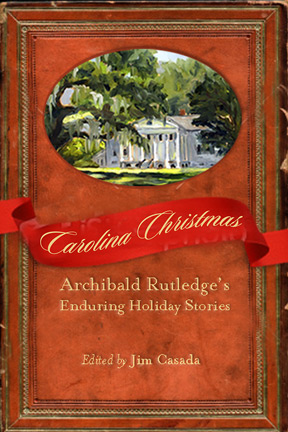
The book, which
I edited and compiled, includes a sprightly selection of his
timeless writings on the holidays at Hampton Plantation and
concludes with a chapter, which my wife and I wrote, of recipes
for festive foods of the season. We took dishes he mentioned in
his writings and provided specific recipes for their
preparation. The hardbound book, which features a lovely dust
jacket in holiday colors and showing Hampton, is $30 + $5
shipping.
A second work
from my hand is my award-winning Remembering the Greats:
Profiles of Turkey Hunting’s Old Masters.
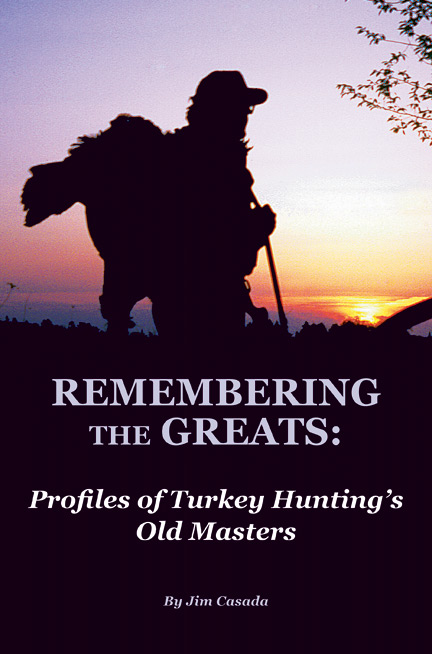
This hardback
features profiles of 27 of the true icons of the sport complete
with extensive photographic support, bibliographical notes with
each chapter, and a true excursion into the sport’s rich
history. Ideal for a turkey hunting friend, the book is $40 + $5
shipping.
Still on the
turkey front, there are two new paperbound works out on the
sport, Gary Sefton’s delightful Lessons Learned from the
Magnificent Bird (200 pages, illustrated).
Gary is a
longtime friend, one of the sport’s genuinely grand guys, a
fellow who has written some delightful songs, and just a jewel
when it comes to sharing a hunt camp. I was able to help him a
bit with this book when it came to editing and take my word for
it, the book is a dandy. It’s $17.50 + $5 shipping.
The other
work is another effort from Wisconsin hunter John Weber,
Stray Shot: Tales from the Turkey Blind and Beyond (227
pages, signed). It is also $17.50 plus $5 shipping.
I’ll have more
book offerings next month, but take a gander at my Web site,
and you’ll find hundreds of new
and used books in a wide variety of fields.
Tel.: 803-329-4354
E-mail: jc@jimcasadaoutdoors.com |
Back to Top
In Praise of
Pocketknives
Case--Buck--Barlow--Remington--Gerber--Schrade. Once these and other
brands of pocket knives were names with which to conjure, instantly
recognizable to an appreciable percentage of the population, at least in
this part of the world. Folks took pride in carrying, displaying, and
using their knife of choice, and most males over the age of 12 carried
one. Youngsters looked on the acquisition of their first knife as a
significant rite of passage while fathers considered a two- or
three-blade pocketknife as indispensable as car keys or work tools.
Grizzled old codgers in country stores or beneath shade trees on small
town squares swapped blades, whittled, and told tales as an integral
part of their daily routine. Pocketknives were an important part of
life.
How things have changed.
A few years back I visited the local Social Security office. A genial
gentleman in uniform greeted me at the door with a cheery “good morning”
and the comment: “You look like a man who would carry a pocket knife.”
I thought that strange but took it as a compliment and enthusiastically
replied: “Yep. As a matter of fact I’m carrying two.”
That wasn’t what he wanted to hear. Politely but firmly, he informed me
I couldn’t enter the building carrying a pocket knife, and of course the
same holds true for boarding an airplane or entering many public
buildings, a pointed reminder of how dramatically society has changed
since my 1950’s boyhood.
A few weeks back I noticed a news piece about a boy getting in trouble
for carrying a pocket knife to school. It seemed pretty innocuous, at
least on the surface. A teacher apparently noticed a bulge the knife
sticking out of his pocket. Nothing more. Obviously the boy broke school
rules and had to face the consequences, but the hapless lad’s situation
speaks volumes about the world in which we live as well.
When I was a teenager in the 1950s, virtually every boy carried a pocket
knife, not only when fishing or hunting but in school as well. The few
who didn’t wished they had one. If a female teacher asked whether anyone
had a knife to assist her with some classroom chore, chances were every
boy in the class raised his hand in a fashion far more enthusiastic than
responses to academic questions. We boys used pocket knives for
recreation and in all sorts of practical ways: gutting and scaling a
mess of fish, cleaning squirrels or rabbits, widening the opening in a
split shot so it could be easily affixed to a fishing line, or
performing any of dozens of chores around home. We were taught practical
knife safety and how to use a whet stone. The standard measure of
whether a knife blade was sufficiently “keen” involved seeing if it
would easily shave the hair off one’s forearm. If not, it needed
additional sharpening.
And if boys of my generation took pride in carrying a pocket knife,
adults considered them absolutely essential. At Loafer’s Glory, as the
town square where I grew up was known, knives were a focal point of
activity second only to playing checkers. There was constant knife
swapping, with exchanges of blades vying with swapping of lies for pride
of place. Genial arguments about the comparative merits of different
styles such as Barlow (not only a brand name but a two-bladed knife),
Stockman (three blades), and Congress (four blades) were commonplace.
The same held true when it came to allegiance to a particular
manufacturer.
Those knife lovers were old men enjoying well-earned leisure after a
lifetime of hard work, but the folding blades they traded and talked
about were also the quintessential working man’s tool. Neither my father
nor paternal grandfather would have even thought of setting foot out of
the house without their trusty knife handy. Both owned a goodly
selection from which to choose, and thanks to disappointment from early
boyhood at not getting a knife one Christmas, Daddy saw to it that his
sons and later his grandsons were always appropriately outfitted in that
department.
While writing this column I paused to ponder how that knife has been
used over the course of the last year or so. The varying work
accomplished with it, and I know the list which follows is but a select
sampling, amazed me—harvesting garden vegetables such as squash,
cabbage, eggplant, okra, cucumbers, and zucchini; peeling apples and
peaches; suckering tomato plants; cutting off sections of twine to tie
tomatoes to stakes; gathering gladiolas, zinnias, snapdragons, and
dahlias from the flower garden for household decoration; opening daily
mail and shipments of books; extracting briars from my fingers; cleaning
trout; removing giblets from wild turkeys; whittling a piece of wood to
hold a latch in place; prying open the lid on a balky toothbrush so the
battery could be replaced, and much more. Simply put, without a knife it
would be difficult for me to function.
Even in his later years, to the age of a hundred and beyond, my father
always kept a pocketknife handy. Dad kept his knives razor sharp,
rightly reckoning that one which wasn’t finely honed wasn’t fit to
carry. Today I proudly carry one of Dad’s pocket knives, as do my
brother, all of his boys, a first cousin, and even my daughter. I can’t
speak for the others, but the little two-blader I carry, with its bone
handles and simple design, gives me a momentary mental boost every time
I take it out of my pocket. It’s a constant reminder of a time when
folks lived close to the earth and a knife was considered a necessity.
Today’s urbanized world seems increasingly out of tune with a lifestyle
where pocket knives deserve praise and a prominent place in daily life.
They are, in short, increasingly part of a world we have lost. How
terribly sad.
Back to Top
Recipes and Thoughts on Food
|
Last month’s newsletter included mention of persimmon pudding
and a recipe for its preparation. I thought I’d include a photo
of the “makin’s” of pudding plucked from my Oriental persimmon
trees, and whether you are dealing with wild persimmons and the
additional requirements they impose in terms of preparation, or
giants such as those pictured here, a persimmon pudding is a
mighty fine treat for the sweet tooth. I hope to prepare one for
Thanksgiving along with a candy roaster pie made from some fine
specimens of that grand old winter squash which came my way
thanks to Tipper Pressley (see above) having used a piece of
mine, “A Craving for Candy Roasters,” as a guest contribution to
her blog.
Mainly though, as I sit here with the skies grey, drizzle
falling, and a chill in the air, my thoughts turn to soup at
this time of year. Yesterday the good lady of the house prepared
a big pot of bean and ham hock soup, and it’s flat-out something
to soothe and satisfy the inner man. A few days before that we
had tomato dill soup, one of our favorites, and there will be
soups or hardy stews on the menu on a pretty steady basis in the
coming months. On occasion they will be nicely rounded off by
biscuits or cornbread. Here are some soups you might want to
try, and next month I’ll try to remember to include Tipper
Pressley’s cream biscuits recipe (my, but they are fine) and our
favorite way of making cornbread.
Before getting to individual recipes, I’ll offer a general note
on tomatoes. Several of the recipes below call for tomatoes in
various forms. While it is fine to buy and use canned tomatoes,
we rely on those from our freezers (yep, we have two of them,
and they are jam packed). For the most part we simply remove the
core and cut a cross in the top of each tomato, then place them
in hot water just long enough to allow us to slip the skin off.
Then we freeze the tomatoes whole. Once thawed, they can be
chopped up, left whole, or used in about any way you would
employ diced or stewed tomatoes or even juice. You have the
seeds left (they are removed from store-bought juices) but to us
that’s no problem. |
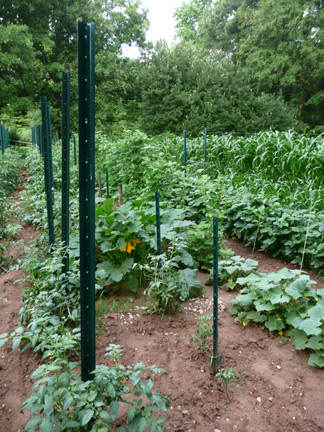
This photo from my garden in July gives visual promise of
foodstuffs
which will be mighty welcome in the chilly days of fall and
winter.
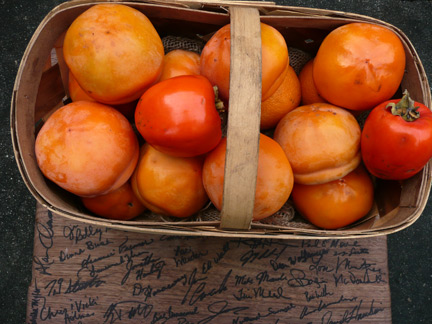
A basket of Oriental persimmons atop the signed walnut cutting
board
given to me at the SEOPA conference.
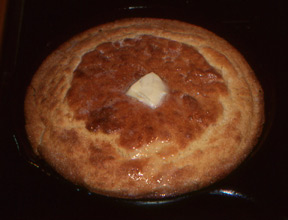
A fine pone of cornbread fresh from the oven.
|
CABBAGE PATCH SOUP
1 pound ground beef or venison
2 medium onions, thinly sliced
1 ½ cups coarsely chopped cabbage
½ cup chopped celery
1 can stewed tomatoes
1 can kidney beans with liquid
1 cup water
1 teaspoon salt
¼ teaspoon pepper
1 to 2 teaspoons chili powder (to taste)
Cook and stir meat in a Dutch oven or large pot until brown (if you use
venison which has been ground without any suet being added you will need
to use a bit of canola oil). Drain then add onions, cabbage, and celery.
Cook mixture and stir until vegetables are lightly browned. Stir in
tomatoes, kidney beans, water, salt, pepper, and chili powder. Heat to
boiling and then reduce to a slow simmer for a further 10 minutes of
cooking.
VENISON AND NOODLE SOUP
1 pound venison, diced into small cubes
2 tablespoons canola oil
1 14½-ounce can tomatoes
1 8-ounce can tomato sauce
1 tablespoon plus 1 teaspoon beef bouillon granules
¼ teaspoon black pepper
2 teaspoons dried basil, crushed
½ teaspoon dried marjoram, crushed
1 bay leaf
5 cups water
1 package (16 ounces) mixed vegetables
2 cups uncooked noodles
Brown venison in oil in a Dutch oven. Drain if necessary. Stir in
tomatoes, tomato sauce, bouillon, black pepper, basil, marjoram, bay
leaves, and water. Bring to a boil, reduce heat and simmer, covered, for
one hour. Add vegetables and noodles. Simmer, covered for 10 to 20
additional minutes or until vegetables and noodles are done. Remove bay
leaves. Makes 8 to 10 servings.
CABBAGE SOUP WITH VENISON MEATBALLS
1 pound ground venison
1 egg
½ cup seasoned bread crumbs
1 tablespoon dried parsley flakes
2 tablespoons canola oil
1 onion, chopped (1 cup)
1 clove garlic, minced
1 cup sliced carrots
1 cup chopped celery
2 potatoes, peeled and chopped (about 2 cups)
4 cups shredded cabbage
2 14-ounce cans double-strength beef broth
2 cans water
1 bay leaf
½ teaspoon thyme
Salt and pepper to taste
Combine ground venison, egg, bread crumbs and parsley. Shape into small
teaspoon-size meatballs and place in refrigerator for at least 30
minutes.
In a large soup pot or Dutch oven heat two tablespoons of canola oil and
brown meatballs in single layers. Remove and set aside.
Add onion and garlic to pot. Sauté until tender. Add carrots, celery,
potatoes, cabbage, broth, water, bay leaf, and thyme. Bring to a boil.
Simmer for 20 minutes. Add meatballs and simmer an additional 10
minutes. Adjust seasonings and add salt, more parsley, if desired, and
pepper. Simmer until all vegetables are soft. Makes six servings.
VENISON ITALIAN SOUP
½ pound ground venison
¼ cup chopped onion
1 14-ounce can Italian stewed tomatoes
1 16-ounce can peeled tomatoes, chopped
1 10½-ounce can double-rich beef broth
1 8-ounce can mixed vegetables, drained
½ cup kidney beans, drained
1 5-ounce package frozen, chopped spinach, defrosted
1 teaspoon Italian seasoning
¼ teaspoon garlic salt
1 teaspoon parsley
¼ teaspoon black pepper
½ cup uncooked macaroni noodles
In a large sauce pan or Dutch oven brown venison and onion. Add
tomatoes, broth, vegetables, and seasonings. Bring to a boil; add
noodles. Reduce heat to medium and cook10 to 15 minutes or until
macaroni noodles are done.
TOMATO DILL SOUP
1 stick butter
1 ½ large onions pureed in a food processor
1/4 cup fresh garlic, minced
1 ½ teaspoons dried dill
¼ tablespoon kosher salt
1/8 tablespoon black pepper
9 cups tomatoes (crushed or diced—that is 2 28-ounce cans plus 1 14
1/2–ounce can)
3 cups water
2 cups heavy cream (a pint of half-and-half with some whole milk added
will work)
Place butter, onions, garlic, dill, salt and black pepper in a large
covered pot. Sauté on low heat until onions are translucent. Add
tomatoes and water. Simmer for 1 to 2 hours. Remove from heat and blend
in cream.
Back to Top
Thank you for subscribing to the
Jim Casada Outdoors
newsletter.
Feel free to contact Jim with your comments, questions
or suggestions at jc@jimcasadaoutdoors.com.
|






